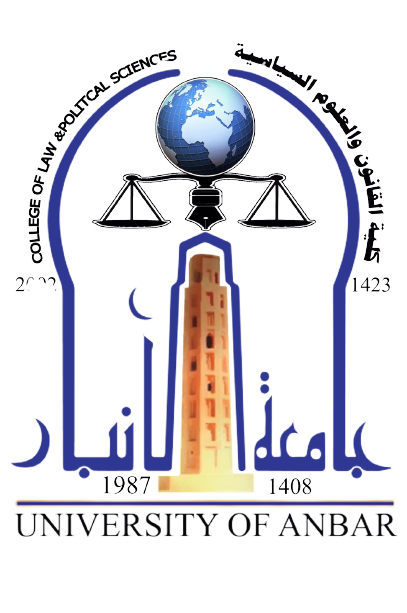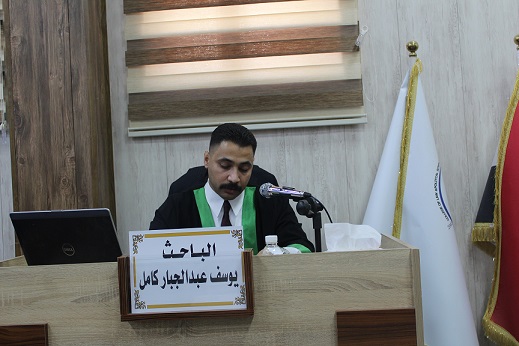
Scientific Article
Protecting Public Decency in the Digital Space: Toward a Balanced Legal Framework
By Prof. Dr. Moataz Ali Sabar
Head of the Law Department at Al-Anbar University
This article begins with a question:
How can we achieve a balance between freedom of expression in digital spaces and the need to protect public decency without infringing on users' fundamental rights?
Public decency is an ethical and value system aimed at fostering peaceful coexistence within society. Historically, it was regulated primarily in the physical, real-world domain. However, the digital revolution and the emergence of electronic spaces have necessitated a reconsideration of the concept of public decency and its reorganization in an environment that transcends traditional limits of time and space. In this regard, the role of law has emerged in creating a system that governs individuals' behavior in digital spaces, ensuring the protection of public decency while maintaining a balance with freedom of expression. This article reviews the conceptual framework of the relationship between law and public decency in light of digital transformation and analyzes the key challenges associated with this, while offering proposed solutions to achieve the desired balance.
Laws are a fundamental tool for organizing social life and ensuring community stability, as they define rights and obligations and establish regulations that protect individuals and preserve their freedoms. However, there is another equally important aspect beyond legal texts, namely public decency, which refers to the values, norms, and traditions accepted by the community as a standard for socially acceptable behavior.
The Nature of Public Decency
Public decency consists of unwritten rules that govern individual behavior, ensuring respect for the feelings of others and community values. It represents a form of mutual respect and consideration for what is appropriate and acceptable, and it evolves with changes in time, space, and culture, while remaining a crucial foundation for social harmony.
With the rise of digital transformation, the scope of public decency has expanded to include behaviors and practices on electronic platforms, including the nature of published content and the way individuals interact on digital platforms.
The Role of Law in Protecting Public Decency
While public decency is based on social norms, law intervenes to protect it when it is clearly threatened or when violating it causes disputes or harm to the public interest. Many legal texts have criminalized acts that violate public decency, such as engaging in indecent behavior in public places, wearing inappropriate clothing, or using offensive language in open spaces. The law here does not seek to suppress personal freedom but aims to define its boundaries in a way that does not harm the rights of others or disturb public order, thereby fostering an environment of respect and coexistence.
There is also a need to establish mechanisms to ensure a balance between personal freedom and the protection of public decency. This is where the greatest challenge lies: finding a delicate balance between respecting individual freedom and the need to protect public decency. For example, freedom of expression or personal attire remains protected as long as it does not exceed the bounds of public decency, causing offense to others or violating shared values. The role of legislators and judges, therefore, is to draw this fine line flexibly, taking cultural peculiarities into account while respecting constitutional principles.
The Relationship Between Law and Public Decency in the Digital Transformation
With the rapid pace of digital transformation and the widespread use of social media and digital platforms, public decency has gained significant importance in the digital space. This has necessitated legal intervention to regulate digital behaviors in a way that preserves social values and protects public order. The preservation of public decency is no longer confined to traditional spaces but has extended to virtual environments, which have become an essential part of daily life.
Regarding the nature of the relationship between law and public decency in the digital age, we examine the following:
-
Regulating Digital Behaviors
Countries have enacted digital laws to regulate the content published on the internet, especially on social media platforms, to ensure it aligns with public decency. This includes prohibiting the publication of offensive images or videos (e.g., degrading content), the use of foul language, offensive symbols, or the public display of immoral acts such as drinking alcohol or blasphemous statements on social platforms. -
Protecting Social Values on Digital Platforms
The law serves as a tool to protect society from moral decay or offenses against public decency in the digital space. The digital opening has led to the emergence of moral deviance, an increase in hate speech, and defamation.
Key areas where the law intervenes to regulate digital public decency include:
-
Enacting Legislation Against Cybercrimes:
This includes laws criminalizing online offenses such as spreading obscene or immoral content, inciting hatred and discrimination, or insulting religious and national symbols. -
Criminalizing Defamation via Digital Media:
A crucial legal area in the digital age, especially given the rise in digital media use and social networks, where verbal or behavioral violations can harm others and cause moral or material damage, such as defamation, slander, or posting images or videos without consent. -
Restricting Content Contrary to Public Morality:
Some laws penalize the publication of videos featuring nudity, sexual innuendo, or foul language, even on personal accounts, as such content violates public decency and threatens social values. -
Establishing Publishing Regulations on Digital Platforms:
Laws may require licenses for influencers or content platforms or mandate users to comply with "digital codes of conduct" that set standards for public decency and responsibility. -
Regulatory Oversight by Authorities:
Regulatory bodies such as telecommunication authorities or relevant ministries have the authority to block harmful websites, ban abusive accounts, or prosecute violators through social media monitoring departments. Additionally, the role of security agencies in Al-Anbar Province has been pivotal in monitoring and holding accountable those who attempt to offend public decency in the region. -
Encouraging Reporting of Inappropriate Content:
There is a need to establish formal platforms that facilitate citizens in reporting violations of public decency, ensuring protection for whistleblowers.
Conclusion
Digital transformation has redefined many legal and social concepts, and public decency is one of the most significant concepts requiring effective legal adaptation. In light of this, maintaining a balance between safeguarding individual freedoms and protecting public decency remains a complex challenge. This requires a comprehensive legislative and educational effort, with a continued commitment to flexible legal frameworks responsive to the rapidly changing digital environment.
It is clear that digital transformation has expanded the law’s responsibility to regulate public behavior, extending to virtual spaces. This calls for the development of new legal tools capable of addressing digital violations of public decency. However, this task remains fraught with challenges, particularly in balancing societal values and individual freedoms, as well as the difficulty of effective oversight in a rapidly evolving environment. Thus, the future of digital public decency protection requires a flexible, cooperative legislative system that promotes cultural respect, utilizes modern technological tools, and adheres to a fair and balanced legal framework.




